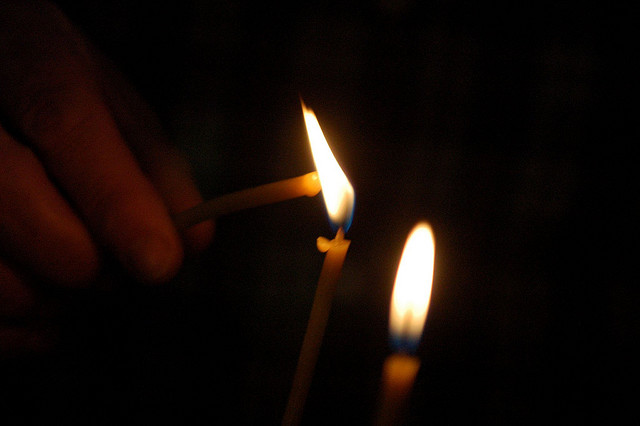Human beings flourish in relationship with other human beings. The religious traditions have always known this. The scientific tradition identifies this when it describes human beings as “small group primates”.
What happens when something interferes with our ability to connect with other “small-group primates”?
Many traditions symbolize this in the lighting of candles. A candle can only come to life when kindled by another flame. But fire is dangerous. It not only casts a bright light, it burns as well.
“Getting burned” has worked its way into the English language as the experience of getting hurt in a relationship. When children “get burned” early in life, or when a teenager or young adult “gets burned” such that he or she develops an unconscious fear of others, they may come to prefer the relative safety of darkness to the risk of light.
But isolation is never a solution when we are created (or evolve) for relationship with others. A profound sense of loneliness sets in. Because the drive to connect and relate is so strong, when we experience emotional isolation, we look for other ways to resolve the pain.
This is the origin of a sexual addiction. Sexual stimulation replaces the much more powerful and satisfying stimulation of being in relationship that is characterized by affirmation, validation, attention, appreciation, a willingness to listen, and other qualities that characterize a healthy, intimate relationship.
Healing from sexual addiction is not about stopping a certain behavior. You are not in recovery when you stop surfing porn, stop hooking up, or stop sexting. The healing begins when you begin to practice the habits of healthy intimacy.
The habits of healthy intimacy enable you to connect with other human beings in relationships that enable you to flourish. Once you begin to experience that quality of interaction with another human being that helps you become whole, the obsession and compulsion associated with hyper-sexual behavior evaporates.
It is replaced with what you truly hunger for.
Before you can learn to connect with others, you must learn to connect with yourself. Some say, you must learn to “love yourself”. And love is a fine term if you know what it means. The problem is that most people who struggle with an addictive process do not understand what the word “love” really means.
They do not have the experience of love. When they hear it, use it, or think about it, they do so only within the context of a culture that does not know what love really means. This may be one reason so many marriages fail. They are grounded in an understanding of “love” that undermines the health of the relationship.
Imagine being married to someone who lacks the capacity to connect deeply with you. The marriage breaks because one partner lacks the habits of healthy intimacy. When one partner withdrawals out of a fear of connection, or out of an inability to connect, the other partner gets out of practice. Intimacy flees the relationship.
Over time the relationship becomes a place of pain rather than a place of mutual support, caring, and a safe place to simply be.
If healing is not brought to the relationship as each person learns to practice the habits of intimacy, the only option will be an addictive process of one kind or another as each person seeks to soothe their deep and abiding loneliness.
The basic goal of treatment for sexual addiction is to encourage the habits of healthy intimacy. Most often this begins with addressing places in a person’s consciousness where the emotional fabric has been torn in such a way that it undermines a person’s ability to practice intimacy with another human being.
Once the emotional net has been restored, a therapist can begin coach the person in the habits of intimacy. This is best learned within the context of a group. The group provides the “lab” or the “classroom” where new behaviors can be learned and practiced without fear of an emotional attack when early attempts at connecting are necessarily clumsy — as all new skills are at first.
Healing from sexual addiction is possible. But it takes time. It takes work. It takes a willingness to invest in becoming a new person. You move from someone who lives with the silent pain of isolation, to becoming a person lives in the joy of healthy relationships with others.
For your flame to shine bright in the darkness, you need someone who can light your candle without burning your whole house down.

